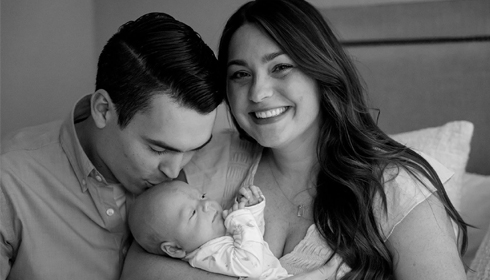
A Miraculous Journey: How US Doctors Saved Mom & Baby from HELLP Syndrome and X-ALD
Morgan Phillips, a marketing and communications specialist for the Department of Obstetrics and Gynecology at UT Southwestern Medical Center, and her husband, Stephen Phillips, were overjoyed when they discovered they were expecting in late October 2023. Morgan's pregnancy went successfully until the 32-week point, when a routine check-up turned into a life-threatening experience that stretched the limits of modern medicine.
A routine check-up revealed Morgan's blood pressure to be high. The following week, her blood pressure spiked, prompting a visit to UT Southwestern's William P. Clements Jr. University Hospital for potential preeclampsia. Despite treatment, her condition deteriorated.
"This was never part of our plan," Morgan explained. "Our nursery wasn't ready, we didn't have a car seat with us, and I started spiraling," Morgan explained.
Morgan's condition worsened at 34 weeks when she developed severe upper abdominal pain and difficulty breathing. Blood tests indicated frightening readings consistent with HELLP syndrome, a rare and potentially fatal pregnancy condition that affects only 0.6% of cases. Dr. Jamie Morgan, her maternal-foetal medicine specialist, commented, "I'd never seen anything like this before."
Doctors acted quickly as liver enzymes spiked, platelets plummeted, and red blood cells broke down. Under general anesthesia, doctors performed an emergency caesarean section to deliver Baby Jude. However, his appearance was grey and lifeless, requiring rapid resuscitation prior to his transfer to the newborn intensive care unit (NICU).
While Morgan spent three days in the ICU recovering from the severe effects of HELLP syndrome, Jude had his own set of obstacles in the NICU. Dr. LaKeitha Foster Truehill, Jude's neonatologist, emphasized the unique care model at UT Southwestern: "We bring parents into the conference rooms during rounds to ask questions and understand the care plan." It's quite hands-on.
Among the relief of Jude's recovery came unexpected news: his newborn screening revealed a rare genetic disease known as X-linked adrenoleukodystrophy (X-ALD). X-ALD affects 1 in 14,000 to 17,000 people and hinders the body's capacity to break down very long-chain fatty acids, which can lead to nerve and adrenal damage over time.
Morgan informed me that we learned about Jude's diagnosis while we were both still in the hospital. "It is hard. We never expected our tale to be like this."
Jude was treated by a multidisciplinary team from UT Southwestern and Children's Health, including pediatric geneticist Dr. Luis Umaña. "We are one of the few places where patients continue receiving care from childhood to adulthood," he told me. The team's thorough strategy ensures Jude receives timely interventions as needed.
The competence applied to Morgan's case as well. Dr. Gary Cunningham, a famous obstetrics expert, conducted more research that revealed a link between her X-ALD carrier status and her severe HELLP syndrome. "There's no way to definitively prove it, but we have a strong suspicion," said Dr. Jamie Morgan.
Six months later, Morgan and Jude are doing well. Morgan is still recovering, with her kidney function largely restored, while Jude is a "smiley and giggly" infant with no obvious signs of X-ALD. His care team is alert, prepared to provide therapies as needed.
Reflecting on their ordeal, Morgan expressed thanks for the specialist treatment they received. “If I had been somewhere else, I truly don’t feel like we would have had this outcome,” she added. "Now we have Jude, who makes us giggle every day. We are so extremely fortunate."